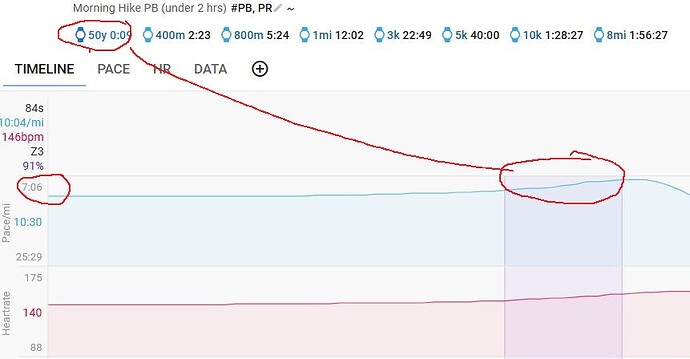Is a 50 yard dash or 50 meters too small to measure with a GPS watch?
The reason I ask is it’s showing I ran 50 yards in 9 seconds but when I look at the pace graph for that section it’s an 8 min/mi pace but 50 yards in 9 seconds is 5:17 min/mi pace.
I was just playing around with the best effort feature . . . At my age (70 yo) I cannot run at top speed for long but that does not keep me from trying every once in a while to see how much I’m improving.
So should I trust that I might have actually ran 50 yards in 9 seconds or would you go by the pace graph that shows 8 min/mile pace?
Click on the PB and the activity chart will zoom in to that part. On the top-left you will have the metrics for that selection. If the map is open, it will also zoom in and colour that part of the track blue.
I know WHERE it was. The question is, can I trust the fact it’s saying I did 50 yards in 9 seconds which is a 5:17 pace but at the same time it shows my pace at that time/place was (on average) 8 min/mi pace (never went over 7:06)
On the activities page for that run it says my max speed was 8.4 mph or 7:09 min/mi pace
But what is it showing top left when zoomed in that section?
The speed graph is a ‘cleaned up’ speed stream. If it would show distance/sec for every point, it would be very jaggy. There’s some smoothing and outlier filtering.
The metrics for a selection/interval are a direct calculation of distance per time unit. Off course, the error will be higher with very short distances. Given the GPS accuracy is somewhere around 3m for most satellite systems (if you have a good signal), the error for 50 yards can be almost 15%. But that will only be true if the GPS points are exactly on the second, which in turn is rather unlikely, so another error is introduced. In some cases, both errors will amplify, in other cases, they will cancel each other out…
So on the question if you should trust it, the answer is more or less, yes, but not without any error. and the error is difficult to pinpoint.
On longer distances, the error becomes a lot smaller.
